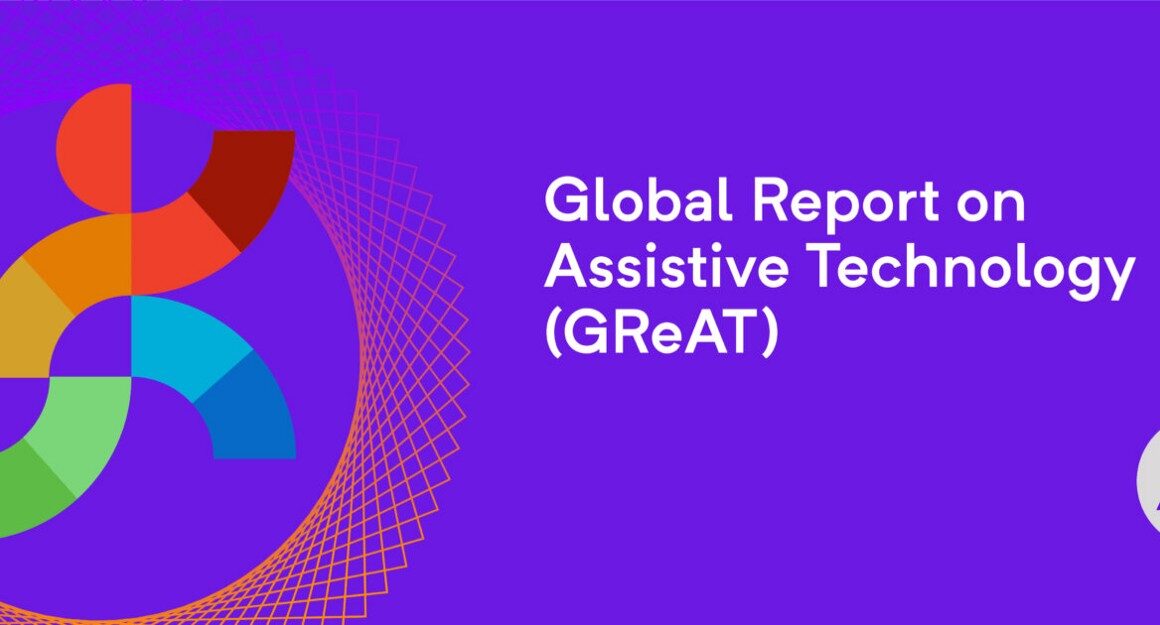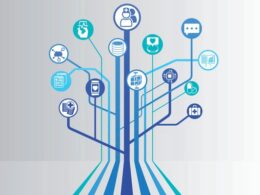WHO & UNICEF Report
Health Policy Watch
Aishwarya Tendolkar
16/05/2022
From wheelchairs to memory aids, over 2.5 billion people in the world today need at least one assistive device …
either for communication, vision, mobility, as well as for certain cognitive functions, like memory aids.
And the number is set to rise to 3.5 billion people by 2050 due to an ageing population and the prevalence of non-communicable diseases, such as heart attack and stroke, which are a major cause of disability.
That’s the bottom line of a first-of-its kind report by the World Health Organization (WHO) and the United Nations Children’s Fund (UNICEF) on the needs and gaps in assistive devices that are critical to the health, safety and independence of billions.
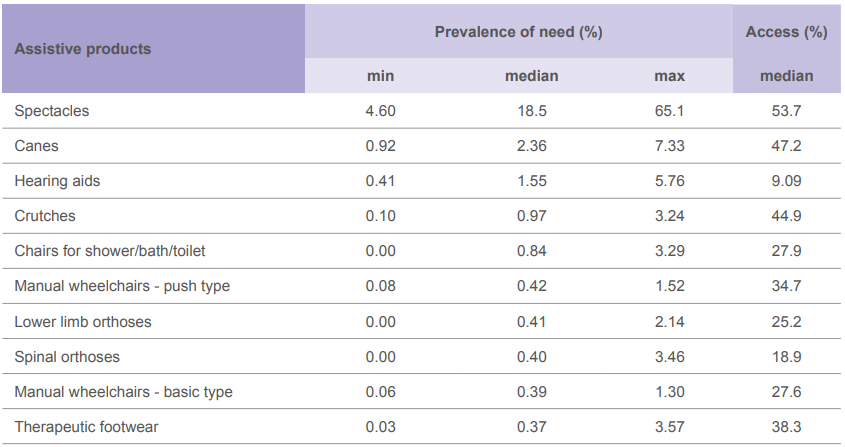
The report also highlights the “vast inequalities in access to assistive technologies in high-income versus low-income countries, ranging from less than 3% in poorer countries to 90% in wealthy ones.
“This is a stunning disparity and is one we can and must address,” Dr Tedros Adhanom Ghebreyesus said at a press conference launch today.
Barriers — lack of awareness, affordability and supply chain challenges
Assistive technology is a broad term covering a wide range of services and devices that range from wheelchairs, protheses, eye glasses, hearing aids and other sorts of communication aids, to pill organizers and other kinds of memory aids.
Assistive technology is a broad term covering a wide range of services and devices that range from wheelchairs, protheses, eye glasses, hearing aids and other sorts of communication aids, to pill organizers and other kinds of memory aids.
“Assistive technology is an umbrella term for the products that people with disabilities and older people need to live their lives more fully,” states the report, adding. “The global need is much larger than previously thought.”
Indeed, the new estimate of needs globally is more than double previous WHO estimates that around 1 billion people need such devices.
…the new estimate of needs globally is more than double previous WHO estimates that around 1 billion people need such devices.
According to the report, barriers to access include a lack of awareness and affordability, inadequate product quality, and procurement and supply chain challenges.
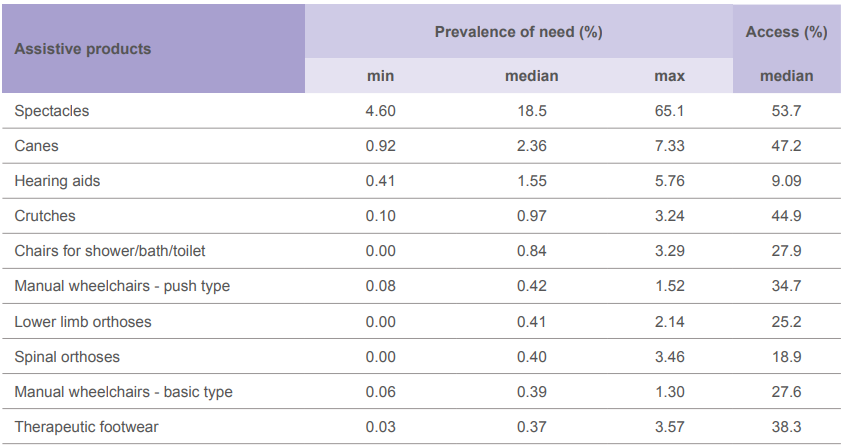
The report for measuring accessibility was made after surveying over 330,000 people from 35 countries in all WHO regions.
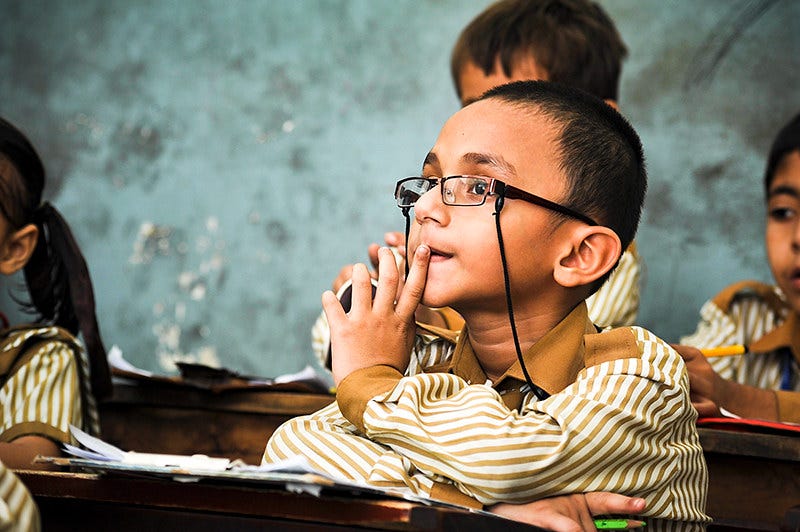
The study found that the most needed assistive product is a simple pair of spectacles. Other products that were in high demand are hearing aids, canes and crutches, chairs for shower, bath and toilet; different types of wheelchairs, orthoses and prostheses.
The study found that the most needed assistive product is a simple pair of spectacles.
High Costs, Low Availability, and Stigmas
The most common barriers to accessing assistive products are their high cost and low availability.
Cost barriers are further exacerbated by the fact that most individuals surveyed reported having paid for assistive technologies from their own pockets — despite the fact that the devices are critical for people to live productive and independent lifestyles.
“Without this technology, people are thrust into poverty and dependency.” Dr Tedros pointed out before calling for governments, donors and civil society to fund and prioritise these neglected but critical products as part of the country’s journey towards universal health coverage.
The most common barriers to accessing assistive products are their high cost and low availability.
The results underscore the importance of having a robust policy in place with legislation and adequate funding, along with permanent implementation systems and structures to ensure universal, rights-based assistive technology access for everyone, everywhere.
The results underscore the importance of having a robust policy in place with legislation and adequate funding, along with permanent implementation systems and structures to ensure universal, rights-based assistive technology access for everyone, everywhere.
“Assistive technology can literally mean the difference between denying or providing a child with all the education or the skills training they will need someday in the workforce, or just a chance to play with friends and contribute fully to their communities,” said Catherine Russell, Executive Director of UNICEF.
She added that such lack of access to basic assistive technologies has very “predictable results like lower rates of school completion, higher rates of unemployment, reduced household income and dependency later in life say nothing of the lasting harm of exclusion and stigma.”
According to the findings in the study, some countries reported that products and technologies also are not gender-friendly — and access may be skewered by gender as well.
Some countries showed that men were twice as likely than women to access assistive products.
The socio-cultural, financial and structural barriers that women face makes them more likely to suffer than men with need for assistive products.
The Way Ahead
The report also makes recommendations on how to better integrate the provision of assistive technologies within health and social care systems.
Among those, it recommends that health systems organise assistive technology services around the person and the environment in which they live, rather than around one particular disease or disability or financing flow.
Furthermore, there is a need for every country to collect and update population-based data in this domain to understand the gaps and trends in the needs as well as supply of such technologies, to enable evidence-based strategies, policies and more comprehensive programmes.
When it comes to humanitarian crises — and on the back of the Ukrainian crisis — the WHO has developed two lists of assistive products for children and adults with disabilities in emergencies.
The first, and most basic list, includes wheelchairs and cushions, elbow and axilla crutches, walking frames and mobile toilet and shower chairs. The second list also includes static toilet, absorbent products and different types of catheter kits — all of which are among the devices most often needed by internally displaced people and refugees.
According to Anne Rabitte, the Irish Minister of State at the Department of Children, Equality, Disability, Integration and Youth and at the Department of Health, the timing is crucial and we need to act now to stop the gap in needs and access. “We know that one in three people require some assistive technology…This number is expected to increase exponentially the potential for innovation and development cannot be underestimated. Timing is important. And the quick key question really is if not, when?”
Image Credits: flickr, WHO/UNICEF, WHO/UNICEF , WHO/Otto Mejía.
Combat the infodemic in health information and support health policy reporting from the global South. Our growing network of journalists in Africa, Asia, Geneva and New York connect the dots between regional realities and the big global debates, with evidence-based, open access news and analysis. To make a personal or organisational contribution click here on PayPal.
Originally published at https://healthpolicy-watch.news on May 16, 2022.
ORIGINAL PUBLICATION
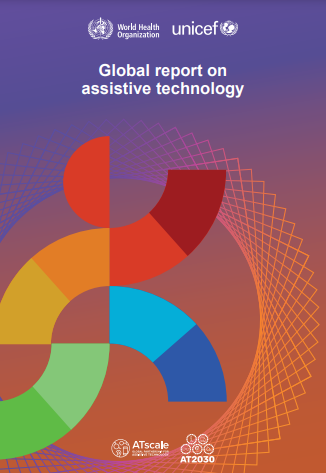
Global report on assistive technology
World Health Organization & United Nations Children’s Fund (UNICEF). (2022). Global report on assistive technology. World Health Organization. https://apps.who.int/iris/handle/10665/354357. Licença: CC BY-NC-SA 3.0 IGO
Names mentioned
Tedros Adhanom Ghebreyesus
Catherine Russell, Executive Director of UNICEF
Moving forward
This report presents ten recommendations intended to guide countries and the stakeholders in their work to progressively improve access to assistive technology and towards universal coverage.
- Improve access to assistive technology within all key development sectors.
- Ensure that assistive products are safe, effective and affordable.
- Enlarge, diversify and improve workforce capacity.
- Actively involve users of assistive technology and their families.
- Increase public awareness and combat stigma.
- Invest in data and evidence based policy.
- Invest in research, innovation and an enabling ecosystem.
- Develop and invest in enabling environments.
- Include assistive technology in humanitarian responses.
- Provide technical and economic assistance through international cooperation to support national efforts.
Recommendation 1: Improve access to assistive technology within all key development sectors.
Assistive technology provision needs to be integrated in all key development sectors, especially within health, education, labour and social care. Every country needs to have an integrated or standalone assistive technology policy and plan of actions with adequate budgetary support to improve access to assistive technology for everyone, everywhere without any financial hardship. Where needed, special focus should be given to children with disabilities, people with multiple or severe impairments, older people and other vulnerable populations.
Recommendation 2: Ensure that assistive products are safe, effective and affordable.
Assistive products should be affordable, durable, safe and effective. This includes developing or strengthening necessary regulatory systems and standards; systematic feedback mechanisms built into the supply chain; provision of assistive products with the support of a competent workforce; and active engagement of users and their families in product selection as well as training on use and maintenance. UN agencies can use their procurement capacity and expertise to ease these barriers via international tendering accessible to governments and other relevant stakeholders, to ensure quality standards are upheld globally and drive best value for money.
Recommendation 3: Enlarge, diversify and improve workforce capacity.
Knowledge, skills, motivation, attitudes and deployment of personnel working in assistive technology sector are keys to success. Adequate and trained human resources of different categories and skills mix for the provision and maintenance of assistive products need to be available at all levels of health and social services — from tertiary to community level. Investments in capacity building of dedicated and allied personnel are needed. The WHO Training on Assistive Products (TAP) and other similar materials can be used for training of the workforce.
Recommendation 4: Actively involve users of assistive technology and their families.
Users and their families should be seen as partners in assistive technology provision, from service delivery design to monitoring and evaluation, not passive service recipients. Assistive technology services need to be organized around the person and the environment they live in, not the disease, impairment or the financing. Users and their family members or caregivers can be encouraged and trained to do simple repair, maintenance and necessary adaptations. Peer-to-peer training and support should be encouraged.
Recommendation 5: Increase public awareness and combat stigma.
Ensure all the key stakeholders — including policy-makers, duty bearers, especially health, education, social care service providers, media and public at large — are well aware of the need for and benefit of assistive technology, including its return on investment. The assistive technology sector can be de-stigmatized through better product design, preferably universal design, and larger acceptance. Political support is required to develop the assistive technology sector to achieve universal coverage through a rights-based approach.
Recommendation 6: Invest in data and evidence based policy.
Every country should have periodical population-based data on the need and demand for, and supply of assistive technology to understand the gaps and trends, in order to develop evidence-based strategies, policies and comprehensive programmes. The WHO rapid assistive technology assessment (rATA) tool can be used to collect population-based data. The assistive technology data collection process can be integrated within other national data collection activities or the health information system, where possible. Investing in good periodic data collection and generating evidence-based policy will support quality services and universal coverage. Establishing a mechanism for sharing experiences, information and evidence can support policy decision-making across sectors and countries.
Recommendation 7: Invest in research, innovation and an enabling ecosystem.
The assistive technology sector is changing rapidly due to technological advances and evolving needs. Considering emerging needs, ageing in particular, investment is urgently needed to ensure assistive products are appropriate, affordable, safe, effective, acceptable and accessible to those who need them most. Investments in research and innovation related to all four key components of assistive technology are needed to increase knowledge, to transform the existing product range and develop new products utilizing emerging technologies, and to develop innovative service delivery processes taking advantage of digital technology, universal design and mainstream consumer products. This can be done in partnership with academia, civil society organizations, in particular with persons with disabilities and older persons and their representative organizations, and the private sector, as appropriate. Such initiatives can be supported by investing in and enabling ‘start-ups’ to overcome challenges and quickly getting products into the market.
Recommendation 8: Develop and invest in enabling environments.
Enabling environments are critical for users’ independence, comfort, participation and inclusion, as they allow users to use their assistive products as intended with minimum effort by the user or caregiver. Enabling environments also benefit everyone. Investment in enabling environments is a key prerequisite to optimize the purpose of assistive technology provision: to enable people to live independently and safely with dignity, participating fully in all aspects of life.
Recommendation 9: Include assistive technology in humanitarian responses.
Assistive technology provision during humanitarian responses increases benefits to potential users to restore productivity and dignity, and at the same time, enhances community ownership and inclusion. Efforts must be made to ensure that users in crisis settings are not further disadvantaged and that new potential users can access the assistive technology they need. Essential assistive products can be included within the essential health care supply and alongside trauma emergency surgical kits. Training materials focussing on taskshifting can be adapted and translated rapidly. Integrated appropriate service provision can be set up to ensure that assistive products and related services are compatible with those to be used in the long term. Emergency response facilities should be barrier-free and inclusive.
Recommendation 10: Provide technical and economic assistance through international cooperation to support national efforts.
As outlined in Article 32 of the UN Convention on the Rights of Persons with Disabilities, international cooperation to support national efforts is necessary to improve access to assistive technology across the world. Such cooperation can support efforts in areas of research, policies, regulations, fair pricing, market shaping, product development, technology transfer, manufacturing, procurement, supply, service provision and human resources. International cooperation is essential to reducing inequity and progressively achieving universal access to assistive technology — and leaving no one behind.




